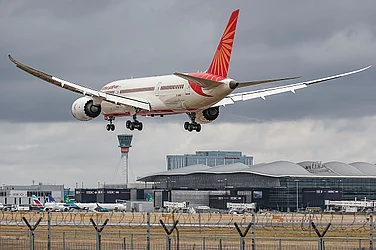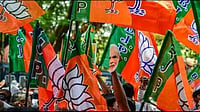As you travel up the mountainous zig-zag road, you suddenly come upon a curve where the huge arches of the Chenab Bridge come into view. Despite their outward closeness, the bridge is still far away, actually 22 kilometres in distance. But as you move close, the engineering marvel begins to open out.
For the residents of this area in the Reasi district of Jammu, travelling on this road is a routine thing. But when they reach the bridge, they stop for a moment. Many pull out their mobile phones, first to take pictures of the structure, which is 35 metres higher than the iconic Eiffel Tower in Paris and then to take selfies. Once they capture the moment, they smile and move on.
Riyaz Ahmad Bhat, a 35-year-old local resident, stopped his two-wheeler on the road and began shouting at the labourers working on the railway bridge below. They didn't seem to hear him. Bhat then tried calling them on his mobile phone, asking whether he should come down to them or if they would come up once the day's work was nearing completion.
Bhat says there was a time when there was no road, and nobody had even considered the possibility of a railway track being built there. "It was all jungle. I remember walking with my father up to my village," he says, pointing towards a mountain around six kilometres away, where his village lies at its foothills.
"Two decades ago it was a difficult journey from one village to another. But once the railways started working on the track, everything started to come up, though slowly, now everything looks great," he says looking towards the village Kauri where the bridge is. "A high-class road, a railway bridge, and jobs for the locals. Sometimes I wonder how it all happened so quickly," he says, surprised by the change.
Chenab Bridge which was completed in March this year is the highest railway bridge in the world constructed by M/S Konkan Railways standing at a height of 1,177 feet. And it is the pride of the area. For the villagers of Salal Kot, Kanthan and other adjoining villages it is a pleasure to see people coming to see the bridge. Though the number of visitors is very less, they feel in the coming years it might become a tourist attraction.
“Once the train starts chugging from the bridge, we expect people will come to see it from their owns eyes,” says a villager at Salal Kot.
The Chenab bridge is a vital component of the 272 km Udhampur-Srinagar-Baramulla rail link project, which began in 2002. This rail link aims to connect the main city of Srinagar with Jammu through rail networks.
Officials say that the bridge is stable enough to withstand an earthquake of up to 8 on the Richter scale and has a life span of 120 years, officials say.
The bridge has a visually impressive or dramatic design, with sweeping arches or curves that give the impression of the bridge taking flight.
To reach the site of the bridge, 26 km of approach roads and a 400m-long tunnel were constructed. The railway project alignment crosses the deep gorge of the Chenab River near the Salal Hydro Power Dam, which necessitates the construction of a mega bridge on River Chenab.
On August 31, 2013, a cable crane was commissioned for the erection of steel arch, trestle, and piers. Four years later on November 2017, an incremental launching over 2.74 degrees circular and a transition curve of 268m length was successfully done for the first time in Indian Railways.
Then on April 2021 a significant part of the construction, joining the 467m long arch span with precision to ensure a perfect fit for the last segment of the arch without any additional stress, was completed.
The other major milestone of the bridge is the “Golden Joint” of the deck. The 785m long deck superstructure was launched from both Kauri and Bakkal ends and was finally joined over the arch. On August 13, 2022, the golden joint ceremony was conducted.
The Prime Minister who has been overseeing the project himself lauded the completion of the arch closure of the Chenab Bridge.
In a tweet, Prime Minister Narendra Modi said that the capability and trust of the countrymen are setting an example before the world. “This feat of construction does not only showcase the growing prowess of India in the field of modern engineering and technology but also is an example of changing work culture marked by the ethos of ‘Sankalp se siddhi’.”
Built at the cost of Rs 1,486 crores, the length of the bridge is 1315 m and the height of the bridge above the river bed is 359 m (1177 ft).
On a site visit on March 26, Ashwini Vaishnaw, Minister of Railways described the bridge as an engineering marvel. He says 28,000 Metric tons of steel fabrication, a strong foundation adding a span of about half a football ground area will play a pivotal role to establish Jammu –Srinagar direct rail connectivity.
“Foundation design of Chenab Bridge was an engineering challenge. The foundation has been built on a vast area having a coverage of half a football ground size to provide adequate stability for the bridge. The Himalayas being a comparatively new mountain, tunnelling work in the Rail route has been an engineering challenge that was sorted out by applying HTM (Himalayan Tunnelling Method) technique developed by Indian engineers,” Vaishnaw says.
He says the Vande Metro trains will link the two cities of the state i.e. Jammu and Srinagar within a short span of 3 to 4 hours of journey time.
He says by the end of December 2023 or January 2024, the entire Jammu – Srinagar section will be ready.
The two sections of the railway are operational in Kashmir from Srinagar to the northern border district of Baramulla and Banihal in Ramban district. For engineers, the challenging part of the construction is ongoing work on the stretch between Katra in Jammu to Banihal in Ramban district, which will complete the rail connectivity of Kashmir with the other states in India.
The railway link is expected to be a gamechanger for Kashmir’s trade, tourism, and transport facility as the treacherous Srinagar-Jammu highway, which is the only road connectivity between Kashmir with the rest of the country is often blocked in the harsh months of winters. On the hilly route surrounded by the mighty Himalayas, landslides are common which block the traffic for days together making people and trade suffer. The landslides often lead to accidents which over the years have claimed thousands of lives. Railway connectivity is expected to ease people from all these challenges.
The train service to Kashmir Chenab Bridge was a challenging task.
As the wind blows fast in the Kauri, Bhat says he will go down to meet his fellow villagers, who work as labourers on the Chenab bridge. For him, the biggest benefit of the railways is that he would be able to reach Kashmir in a short time. “I work in Anantnag district selling clothes. I go to Kashmir through the Gool Gulabgad area. It is a long distance. Once the train service will start, I can easily be back at home every Saturday. I have two children. They too insist on going to Kashmir. What more could you ask for? A hassle-free train ride to Kashmir,” he says smiling.


























